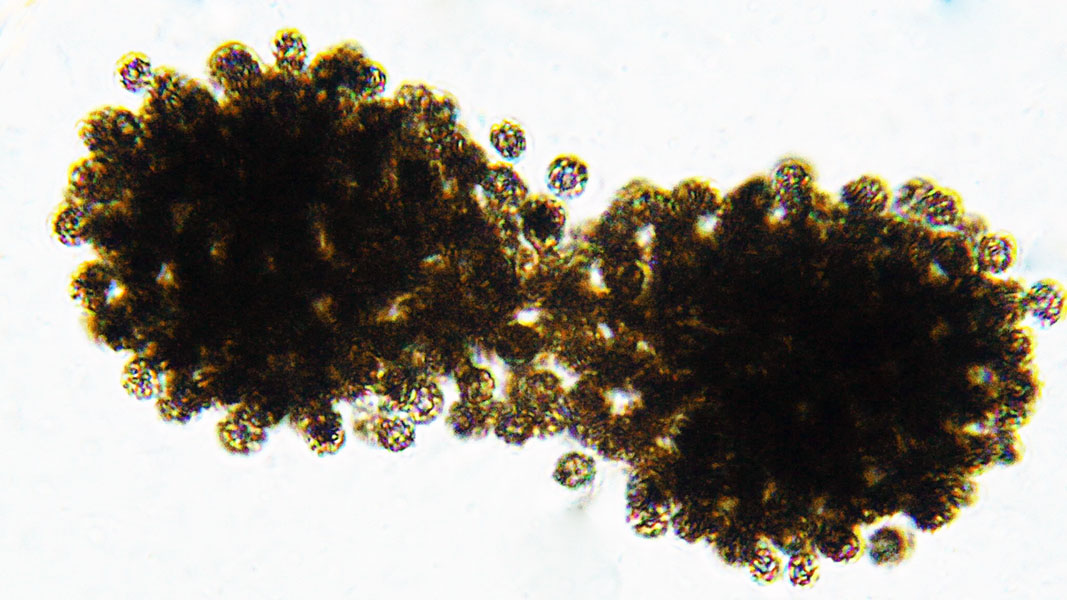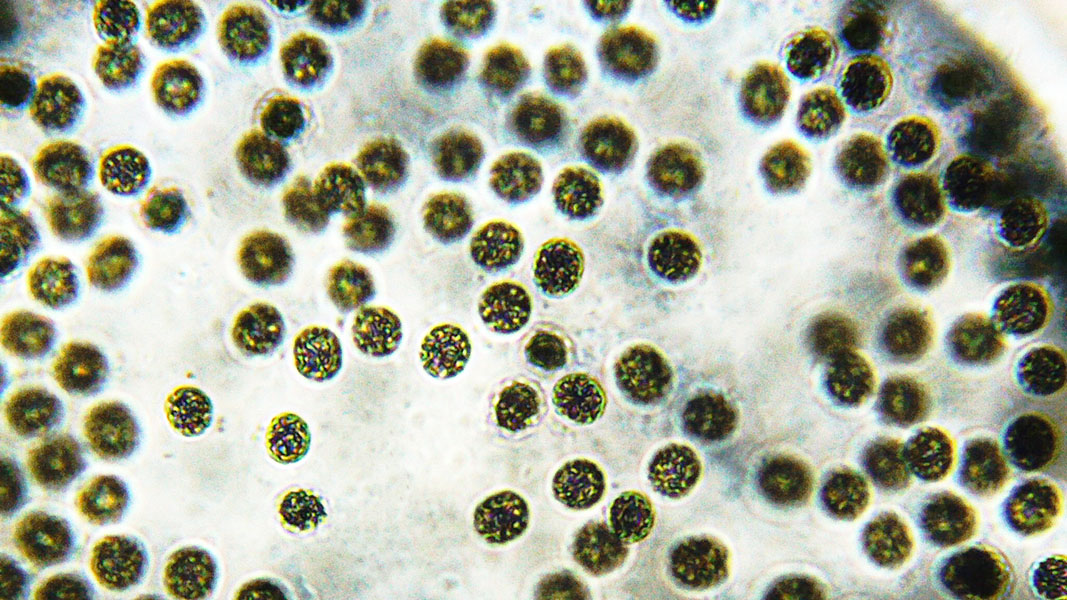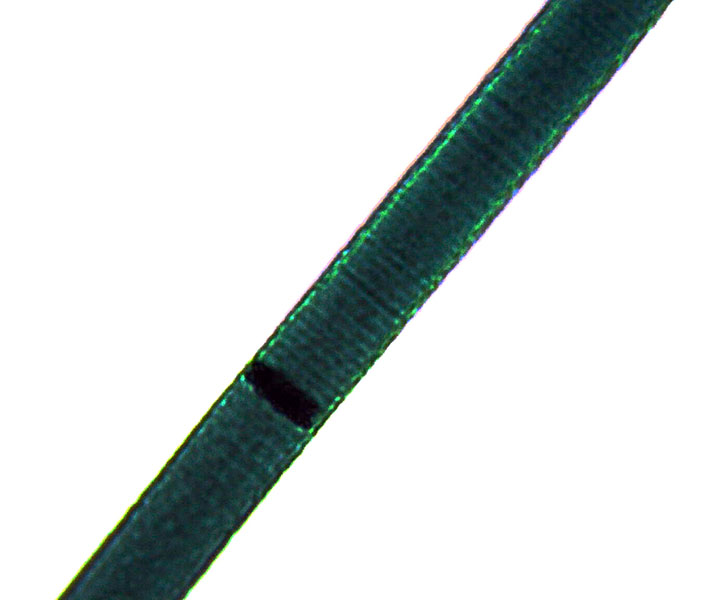Cyanobacteria in Ponds & Lakes
Cyanobacteria identification of some of the common species found in and around lakes and ponds. Analyzing samples of potential cyanobacteria under microscope is the best way to confirm if you have a harmful algal bloom.
Dolichospermum (previously known as Anabaena)
A type of blue-green algae, is found in damp soil and in shallow water as plankton. Dolichospermum can be found as a colony or as single cells. Dolichospermum will cause blooms during summer months or months with increased temperatures. Dolichospermum (anabaena) produces a green paint like film at the water surface.
Dolichospermum under microscope
Dolichospermum bacteria form cells that resemble beads or barrels. These cells connect end to end creating filaments that look like a pearl necklace. These filaments can either be straight, curved or form a spiral. Filaments may include heterocysts, cells that fix nitrogen. The heterocysts are larger than the normal cells and lack color. They are irregularly dispersed in the colonies.
Under a microscope, dolichospermum is similar in appearance to nostoc.
Is dolichospermum harmful?
Dolichospermum can produce a number of cyanotoxins. These toxins include microcystin, anatoxin, cylindrospermopsin, and saxitoxin.
Dolichospermum surface film
Microcystis spp
A type of blue-green algae, is a single cell, but can form colonies with hundreds of cells. When the colonies form, they float to the surface of the water. When cells collect on the surface of the water, this is referred to as a "bloom." Microcystis aeruginosa is found in freshwater with high nutrient levels.
Microcystis blooms usually peak during the warmest months of the year. Growth drops off in the water column in cooler weather. Cells can lay dormant in bottom sediment for extended periods of time.
Microcystis under microscope
Each cell is spherical or ovoidal in shape, but the colonies can vary in appearance.
Is microcystis harmful?
Microcystis can be harmful as it has the potential to produce cyanotoxins, including microcystin and anatoxin. These toxins can pose risks to human health and aquatic life when present in high concentrations.
Even if there is not a current microcystis bloom, scums that have dried along shorelines can still be a threat. These microcystis cells may still contain high concentrations of microcystin for several months after drying. The toxins can dissolve back into the water.


Microcystis bloom
Nostoc
A type of blue-green algae, can be found in soil or floating in calm water. Colonies of nostoc form green jelly-like blobs.
Nostoc under microscope
Within the colonies, spherical cells are linked in chains and held together in a gelatinous structure. Similar to Anabaena, Nostoc has heterocysts that fixate nitrogen.
Is nostoc harmful?
Nostoc can produce the cyanotoxin called microcystin.
Oscillatoria
Oscillatoria is a filamentous cyanobacteria or blue-green algae, which is found in freshwater. This type of bloom is a benthic cyanobacteria. It forms mats which grow in the sediments of lakes and ponds. Oscillatoria can be found in tangled mats or as one cell.
Oscillatoria under microscope
Oscillatoria are dark green filaments which are unbranched. These filaments consist of a series of cells which look like stacked coins. Oscillatoria moves through water by secreting mucilage to push itself in the opposite direction.
Other similar types of cyanobacteria include phormidium, planktothrix, and limnoraphis.
Is oscillatoria harmful?
Oscillatoria can produce the cyanotoxins microcystin and anatoxin.

Phormidium
A type of blue-green algae, found in freshwater streams, ponds and lakes. Phormidium can be found in tangled mats or free-floating in water.
Phormidium under microscope
Phormidium consists of a fine, smooth filament. The connected cells are square shaped. The end of the cell is tapered.
Is Phormidium harmful?
Phormidium can produce the cyanobacteria toxin anatoxin .
Lyngbya
A type of blue-green algae, found in freshwater streams, ponds and lakes. Lyngbya forms dense mats at the bottom of water bodies. These mats are often dark in coloration. The benthic cyanobacteria (bottom growing) can float to the surface due to the trapped gasses in the mats. When lyngbya mats float at the surface they oxidize and shift in color to yellow-orange.
Is Lyngbya toxin producing?
Lyngbya can produce a number of cyanotoxins. These toxins include saxitoxins, aplysiatoxins, lyngbyatoxins, and lipopolysaccharides.
Aphanizomenon
A type of blue-green algae, found in freshwater streams, ponds and lakes. Aphanizomenon can forms clusters of filaments which look grass clippings.
Aphanizomenon under microscope
These filaments form linear chains called trichomes. They are unbranched. The individual cells within a filament are typically cylindrical or barrel-shaped.
Is Aphanizomenon toxin producing?
Aphanizomenon can produce a number of cyanotoxins. These toxins include anatoxin, saxitoxin and cylindrospermopsin.
Cylindrospermopsis
Cylindrospermopsis is a cyanobacteria species found in ponds and lakes. Filaments are generally found free floating in water.
Cylindrospermopsis under microscope
Each filament consists of connected cells that are cylindrical to rectangular in shape and a tapered end cell. The end cell can be pointed.
Is Cylindrospermopsis harmful?
Cylindrospermopsis can produce the cyanotoxins cylindrospermopsin and saxitoxin.
Woronichinia
Woronichinia is a type of cyanobacteria found in ponds and lakes. It produces a film at the surface of the water which can range in color from green, blue-gree, yellowish-brown, or white.
Woronichinia under a microscope
Woronichinia produces dense round or oblong colonies of cells. Woronichinia can be confused with other colony forming bacteria like microcystis. Colonies of woronichinia cells are formed within a mucilaginous film. The colony shape are similar to the shape of pine pollen under a microscope. Unlike microcystis, the woronichinia cells are only one layer thick, with the center of the colony being void of cells.
Is Woronichinia harmful?
Woronichinia is a toxin producing cyanobacteria. The type of toxin produced by woronichinia is anatoxin.
